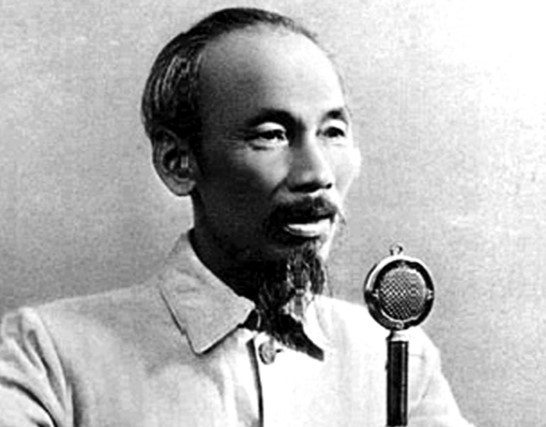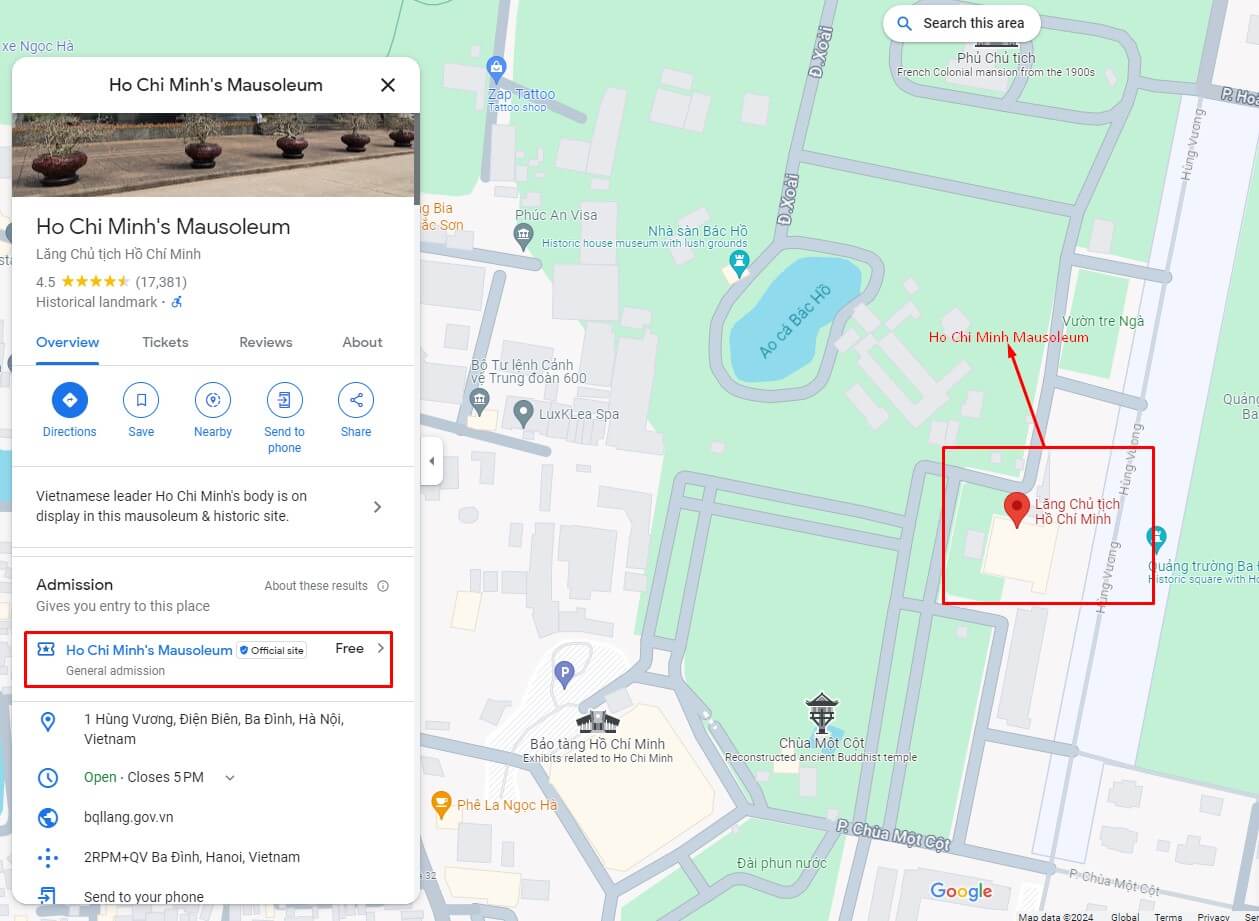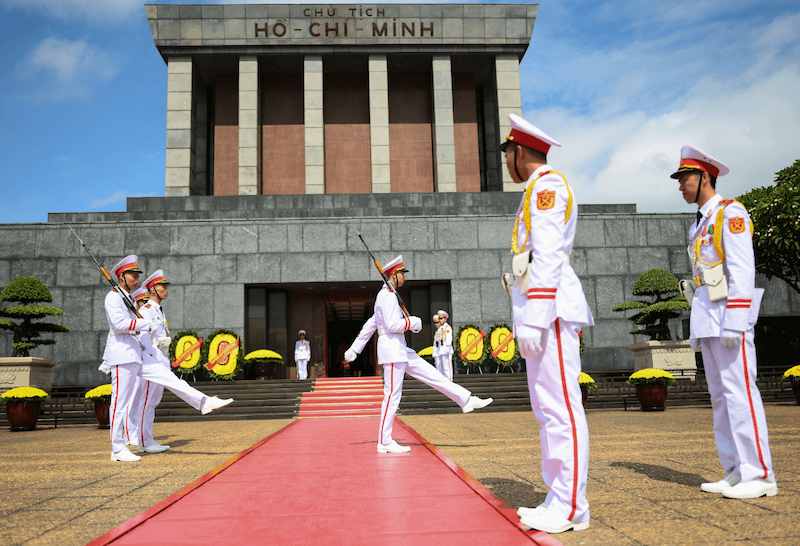The Ho Chi Minh Mausoleum stands as a prominent symbol of Vietnam’s enduring respect and admiration for its revolutionary leader, President Ho Chi Minh. Located in the heart of Hanoi, this mausoleum not only serves as the final resting place of the nation’s hero but also as a significant cultural and historical landmark. Visitors from around the world come to pay their respects and to learn about the remarkable life and legacy of Ho Chi Minh.
Who is President Ho Chi Minh?
President Ho Chi Minh, born Nguyễn Sinh Cung on May 19, 1890, was a pivotal figure in Vietnam’s history. Renowned for his leadership and dedication, Ho Chi Minh led the movement for Vietnamese independence from French colonial rule. He later became a central figure in the fight against the United States during the Vietnam War. Known affectionately as “Uncle Ho” his vision and determination were instrumental in the establishment of the Democratic Republic of Vietnam.
Ho Chi Minh’s journey began with his education in Vietnam and abroad, including time spent in France, the United States, and the Soviet Union. His exposure to various political ideologies and revolutionary movements shaped his approach to Vietnam’s struggle for independence. As the leader of the Viet Minh, Ho Chi Minh declared Vietnam’s independence on September 2, 1945, at Ba Dinh Square, where the mausoleum now stands.

His legacy extends beyond his military and political achievements; Ho Chi Minh was also a poet, journalist, and advocate for education and social reforms. His leadership philosophy, encapsulated in the “Ho Chi Minh Thought,” emphasizes national unity, self-reliance, and the pursuit of peace and social justice.
Where is Ho Chi Minh Mausoleum?
The Ho Chi Minh Mausoleum is strategically located at 1 Hung Vuong, Dien Bien, Ba Dinh, Hanoi, Vietnam. This location is not just a random choice; it holds significant historical and symbolic value. Ba Dinh Square, where the mausoleum stands, is the very place where Ho Chi Minh declared Vietnam’s independence from French colonial rule in 1945. This historic declaration marked the birth of the Democratic Republic of Vietnam, making the mausoleum’s location a place of great national pride and historical importance.

The mausoleum itself is an imposing structure, constructed from marble and granite. Its design was inspired by Lenin’s Mausoleum in Moscow, but it incorporates distinct Vietnamese architectural elements, creating a unique blend of Eastern and Western styles. The structure is surrounded by lush gardens and the grand Ba Dinh Square, adding to its serene and respectful atmosphere. This area is not only a site for reflection but also a place where significant national ceremonies and events are held, further cementing its role as a central pillar of Vietnamese heritage.
Flag Raising Ceremony at Ho Chi Minh Mausoleum
One of the most solemn and patriotic events at the Ho Chi Minh Mausoleum is the daily flag-raising ceremony. Conducted by the honor guard, this ceremony takes place every morning and symbolizes the national pride and respect for President Ho Chi Minh. Visitors often gather early to witness this moving event, which is accompanied by military music and a display of national unity.
The flag-raising ceremony begins at 6:00 AM in the summer and at 6:30 AM in the winter. It starts with a group of soldiers, dressed in pristine white uniforms, marching from the Ho Chi Minh Museum to the front of the mausoleum. The national flag is carried in a ceremonious manner, and as the flag is raised, the national anthem is played, creating an atmosphere of respect and solemnity. This ceremony not only honors Ho Chi Minh but also serves as a daily reminder of the sacrifices made for Vietnam’s independence.
The entire process is meticulously choreographed, with soldiers marching in perfect synchronization, reflecting the discipline and pride of the Vietnamese military. The sight of the red flag with its yellow star being hoisted against the backdrop of the mausoleum is a powerful image, evoking a sense of unity and national identity among the spectators. The flag-raising ceremony is not just a daily ritual; it is a significant cultural event that reinforces the collective memory and respect for Ho Chi Minh and the nation’s history.
The Body of President Ho Chi Minh
Inside the mausoleum, the embalmed body of President Ho Chi Minh is preserved in a glass case, allowing visitors to pay their respects. The preservation of his body was done in accordance with his wishes, as he wanted to remain close to the people he loved and served throughout his life. The mausoleum’s solemn atmosphere and the meticulous care taken to preserve his remains reflect the deep respect and reverence the Vietnamese people have for their leader.
Ho Chi Minh’s body is preserved by a team of Vietnamese and international scientists, ensuring that it remains in excellent condition. The mausoleum itself is a grand structure, built of marble and granite, and designed to evoke the traditional architecture of Vietnamese temples, creating a blend of solemnity and cultural heritage.
The interior of the mausoleum is kept cool and dimly lit to aid in the preservation of the body. Visitors move in a respectful silence as they pass by the glass case, where they can see Ho Chi Minh’s body lying in state. His serene expression and the careful preservation of his features allow visitors to feel a personal connection to the leader who played such a crucial role in shaping modern Vietnam.
The preservation process is a complex and delicate procedure, involving regular maintenance and scientific expertise. The decision to embalm and display Ho Chi Minh’s body was made to honor his wishes and to provide the Vietnamese people with a place to come and pay their respects. This act of preservation has turned the mausoleum into a place of pilgrimage, drawing visitors from all corners of the country and the world.
Information You Need to Know When Visiting President Ho Chi Minh’s Mausoleum
Opening Hours: The Ho Chi Minh Mausoleum is open to the public from Tuesday to Thursday and on weekends (Saturday and Sunday). The hours are from 7:30 AM to 10:30 AM in the summer (April to October) and from 8:00 AM to 11:00 AM in the winter (November to March). It is closed on Mondays and Fridays, as well as for a few months each year for maintenance, typically from September to November.
Entrance Fee: There is no entrance fee to visit the Ho Chi Minh Mausoleum. It is free for all visitors, including both Vietnamese nationals and international tourists. However, donations are appreciated to help with the upkeep and maintenance of the site.
Rules and Regulations: Visitors are expected to adhere to a strict dress code and behavior guidelines to show respect for the site. Modest attire is required, with shoulders and knees covered. Inside the mausoleum, silence must be observed, and photography is strictly prohibited. Visitors are also not allowed to carry large bags or wear hats inside the mausoleum. Security checks are conducted at the entrance to ensure compliance with these rules.

Visiting the Ho Chi Minh Mausoleum is a profound experience that offers a glimpse into the life and legacy of one of Vietnam’s most significant historical figures. It provides an opportunity to reflect on the country’s journey towards independence and the enduring spirit of its people. When in Hanoi, the mausoleum is an essential stop to understand and appreciate the rich history and cultural heritage of Vietnam.
Some questions about Ho Chi Minh Mausoleum
Q: Is the Ho Chi Minh Mausoleum worth visiting?
A: Ho Chi Minh Mausoleum is one of the most worth visiting places when you visit Hanoi.
Q: Can I wear shorts in Ho Chi Minh Mausoleum?
A: The Ho Chi Minh Mausoleum is a highly revered site in Vietnam, so visitors are required to dress respectfully when visiting. Shorts, t-shirts, and hats are not allowed.
Q: What is special about Ho Chi Minh Mausoleum?
A: The most special feature of the Ho Chi Minh Mausoleum is that President Ho Chi Minh’s body is preserved inside a glass coffin, protected by four honor guards standing at each corner.
Q: How long to spend at Ho Chi Minh Mausoleum?
A: You will need about 45 minutes to an hour and a half to tour the Ho Chi Minh Mausoleum, and you can also visit nearby areas such as the Presidential Palace and the Ho Chi Minh Museum (refer to the map above).
Q: Is Ho Chi Minh Mausoleum free?
A: It is free for all visitors, including both Vietnamese nationals and international tourists.
Here are the things you need to know about the Ho Chi Minh Mausoleum. Visit Vietnam Travel Tips daily to learn more about the beautiful country of Vietnam.



Your article helped me a lot, is there any more related content? Thanks! https://www.binance.com/register?ref=IXBIAFVY
Your article helped me a lot, is there any more related content? Thanks!
I don’t think the title of your article matches the content lol. Just kidding, mainly because I had some doubts after reading the article. https://accounts.binance.info/fr-AF/register?ref=JHQQKNKN
I don’t think the title of your article matches the content lol. Just kidding, mainly because I had some doubts after reading the article.
I don’t think the title of your article matches the content lol. Just kidding, mainly because I had some doubts after reading the article.
I don’t think the title of your article matches the content lol. Just kidding, mainly because I had some doubts after reading the article.
I don’t think the title of your article matches the content lol. Just kidding, mainly because I had some doubts after reading the article. https://accounts.binance.info/register-person?ref=IHJUI7TF
Your article helped me a lot, is there any more related content? Thanks!
Your article helped me a lot, is there any more related content? Thanks!
Your article helped me a lot, is there any more related content? Thanks!
I don’t think the title of your article matches the content lol. Just kidding, mainly because I had some doubts after reading the article.
Thank you for your sharing. I am worried that I lack creative ideas. It is your article that makes me full of hope. Thank you. But, I have a question, can you help me?
Your point of view caught my eye and was very interesting. Thanks. I have a question for you. https://www.binance.info/cs/register?ref=OMM3XK51
I don’t think the title of your article matches the content lol. Just kidding, mainly because I had some doubts after reading the article.
Your point of view caught my eye and was very interesting. Thanks. I have a question for you.
Your point of view caught my eye and was very interesting. Thanks. I have a question for you.
I don’t think the title of your article matches the content lol. Just kidding, mainly because I had some doubts after reading the article. https://www.binance.info/en-ZA/register?ref=B4EPR6J0
Thank you for your sharing. I am worried that I lack creative ideas. It is your article that makes me full of hope. Thank you. But, I have a question, can you help me? https://accounts.binance.com/da-DK/register-person?ref=V3MG69RO
Can you be more specific about the content of your article? After reading it, I still have some doubts. Hope you can help me.
Thanks for sharing. I read many of your blog posts, cool, your blog is very good.
Thanks for sharing. I read many of your blog posts, cool, your blog is very good.
Your article helped me a lot, is there any more related content? Thanks!